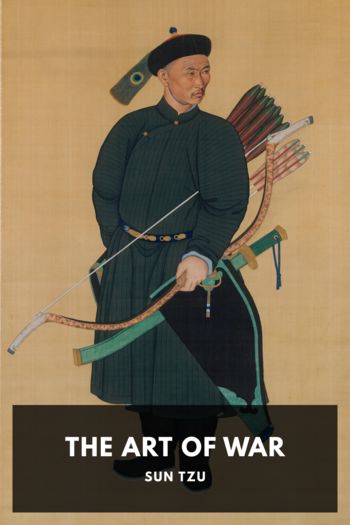Tao Te Ching, Laozi [the gingerbread man read aloud TXT] 📗

- Author: Laozi
Book online «Tao Te Ching, Laozi [the gingerbread man read aloud TXT] 📗». Author Laozi
The Tao Te Ching, ch. 14; et al. ↩
Ch. 50. ↩
That is, between heaven and earth. ↩
Quoted in the Amplification of the Sixteen Precepts or Maxims of the second emperor of the present dynasty by his son. The words are from Dr. Milne’s version of The Sacred Edict, p. 137. ↩
In his index of the Tripiṭaka, Mr. Bunyio Nanjio (p. 359) assigns Liu Mi and his work to the Yüen dynasty. In a copy of the work in my possession they are assigned to that of Sung. The author, no doubt, lived under both dynasties—from the Sung to the Yüen. ↩
See bk. XV par. 1. ↩
Bk. XI par. 5. ↩
Bk. XVI par. 2. ↩
Tao Te Ching, ch. 19. ↩
Confucian Analects, XIV 36. ↩
Julien translates this by “il erre à l’aventure.” In 1861 I rendered it, “He moves as if his feet were entangled.” To one critic it suggests the idea of a bundle or wisp of brushwood rolled about over the ground by the wind. ↩
The character may mean “the old boy,” and so understood have given rise to various fabulous legends; that his mother had carried him in her womb for seventy-two years (some say, for eighty-one), and that when born the child had the white hair of an old man. Julien has translated the fabulous legend of Ko Hung of our fourth century about him. By that time the legends of Buddhism about Śākyamuni had become current in China, and were copied and applied to Laozi by his followers. Looking at the meaning of the two names, I am surprised no one has characterized Laozi as the Chinese Seneca. ↩
Kʽang-sang Tzŭ is evidently the Kêng-sang Chʽu of Chuang’s book XXIII. Wei-lei Hsü is supposed by Ssŭ-ma Chên of the Tʽang dynasty, who called himself the Lesser Ssŭ-ma, to be the name of a book; one, in that case, of the lost books of Chuang. But as we find the “Hill of Wei-lei” mentioned in bk. XXIII as the scene of Kʽang-sang Tzŭ’s Taoistic labours and success, I suppose that Chʽien’s reference is to that. The names are quoted by him from memory, or might be insisted on as instances of different readings. ↩
體道, “Embodying the Tao.” The author sets forth, as well as the difficulty of his subject would allow him, the nature of the Tao in itself, and its manifestation. To understand the Tao one must be partaker of its nature.
Par. 3 suggests the words of the apostle John, “He that loveth not knoweth not God; for God is love.” Both the Tao, Laozi’s ideal in the absolute, and its Tê, or operation, are comprehended in his chapter, the latter being the Tao with the name, the Mother of all things. See the third chapter of the introduction. ↩
養牲, “The Nourishment of the Person.” But many of Ho-shang Kung’s titles are more appropriate than this.
The chapter starts with instances of the antinomies, which suggest to the mind each of them the existence of its corresponding opposite; and the author finds in them an analogy to the “contraries” which characterize the operation of the Tao, as stated in chapter 40. He then proceeds to describe the action of the sage in par. 3 as in accordance with this law of contraries; and, in par. 4, that of heaven and earth, or what we may call nature, in the process of the vegetable world.
Par. 2 should be rhymed, but I could not succeed to my satisfaction in the endeavour to rhyme it. Every one who can read Chinese will see that the first four members rhyme. The last two rhyme also, the concluding 隨 being pronounced so;—see the Kʽang-hsi dictionary in voc. ↩
安民, “Keeping the People at Rest.” The object of the chapter is to show that government according to the Tao is unfavourable to the spread of knowledge among the people, and would keep them rather in the state of primitive simplicity and ignorance, thereby securing their restfulness and universal good order. Such is the uniform teaching of Laozi and his great follower Chuang-tzŭ, and of all Taoist writers. ↩
無源, “The Fountainless.” There is nothing before the Tao; it might seem to have been before God. And yet there is no demonstration by it of its presence and operation. It is like the emptiness of a vessel. The second character = 沖 = 盅;—see Kʽang-hsi on the latter. The practical lesson is, that in following the Tao we must try to be like it. ↩
虛用, “The Use of Emptiness.”





Comments (0)